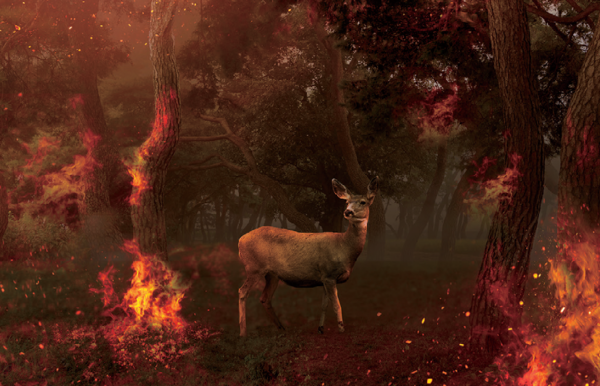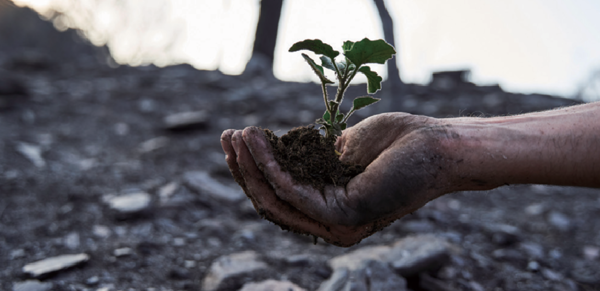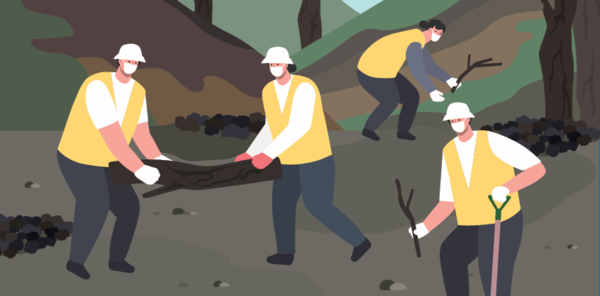Summer has arrived, but the scars of the previous season’s blaze have not yet healed. The wildfire that swept through North Gyeongsang Province this spring left behind the most extensive damage recorded in South Korea’s history. The flames did not stop at devouring the mountains; they also destroyed homes, livelihoods, and the hearts of countless residents. Faced with challenges, the Sungkyun Times (SKT) examines the damage caused by wildfires and explores ways toward recovery.
Decoding the Wildfire
-Sparks of Ruin
Under the Forest Protection Act, a forest fire refers to the burning of trees, weeds, fallen leaves, etc., in a forest or areas adjacent to forests, caused by either artificial or natural ignition. Most wildfires begin as surface fires, burning leaves and underbrush on the forest floor. However, they often escalate into crown fires, which engulf the branches and foliage of trees. Wildfires become especially dangerous when windborne embers — such as pinecones, needles, or twigs — ignite new fires far from the main blaze, a phenomenon known as fire spotting.

This characteristic makes it extremely difficult to control wildfires using only ground-based efforts. As for their causes, they can broadly be categorized into natural factors, such as lightning or friction, and human factors, such as carelessness or arson. Among these, the majority of wildfires are said to be human-induced. Data released in 2025 by the Korea Forest Service (KFS) shows that over half of all wildfires in South Korea over the past decade were caused by human negligence, including accidental ignition or intentional burning practices.
-Evolving Infernos
Wildfires in South Korea are becoming larger in scale and more frequent throughout the year. According to the KFS, the average number of wildfires per year since the 2020s has increased by 18% compared to the 2010s, while the average area burned has expanded by a staggering 7.8 times. For many years, the East Coast wildfire of April 2000, which burned approximately 20,000ha, was considered the worst case in Korean history. However, the record was shattered this March, when a massive wildfire in North Gyeongsang Province scorched around 90,000ha, more than four times the damage caused by the fire in 2000. Traditionally, wildfires in Korea were concentrated in March and April, months marked by low rainfall, dry air, and strong westerly winds. However, the occurrence of wildfires is no longer confined to spring. This shift to a year-round wildfire season is increasingly tied to the effects of climate change, which has brought warmer and drier conditions throughout the year. Consequently, wildfire season extends into both winter and early summer, resulting in a greater number of days each year when wildfires can occur.
A Landscape in Ashes
-Factors That Fuel the Flames
The structural characteristics of South Korea’s forests and shortcomings in firefighting infrastructure have been identified as key reasons for the escalating damage caused by wildfires. The country’s forests are especially vulnerable because flammable conifers dominate over relatively fire resistant broadleaf trees. Among them, the pine tree is considered one of the most dangerous coniferous species for worsening wildfire conditions. Historically used as torch fuel due to its flammable sap, pine burns at a temperature about 1.4 times higher and sustains flames 2.4 times longer than most broadleaf trees. Notably, North Gyeongsang Province has the country’s highest proportion of pine forest, making it especially vulnerable to such disasters. Another major issue is the lack of proper firefighting equipment, which is critical, particularly during the early stages of wildfire. Rapid deployment of helicopters to extinguish the fire is essential to minimizing damage.

However, among the helicopters operated by the KFS, only seven are large models capable of carrying over 5,000L of water. To make things worse, during the recent wildfire, only five were available for use, as two were undergoing maintenance. The overreliance on small helicopters hampered the effectiveness of the recent response, highlighting the critical need to expand South Korea’s heavy lift firefighting helicopters.
-Wildfire Recovery Fallout
Wildfires are sweeping disasters that claim lives, displace entire communities, and obliterate livelihoods in an instant. Forested hills become scorched and barren, while farmland, crops, and equipment built over decades get destroyed within hours. Yet, despite the scale of destruction, recovery remains slow, with many residents still caught in the blind spots of institutional support. Furthermore, the destruction of trees and their roots weakens the soil, making it incapable of effectively absorbing rainfall, increasing the risk of landslides during the summer monsoon. In addition, wildfires leave deep scars on the long-term natural world. They collapse entire ecosystems, accelerating climate change, weakening soil fertility, and endangering rare species.

On top of this, considering a single tree can sustain over a hundred life forms, when consumed by fire, it leads to the disappearance of countless organisms. As reported by the KFS, it typically takes around 35 years to repopulate wildlife in areas, while full soil recovery requires up to 100 years. However, forest restoration is no simple task. In an interview with the SKT, Lim Chi-hong, an assistant professor of Bio & Environmental Technology at Seoul Women’s University, commented, “Forest restoration is difficult to resolve with a single solution or purely ecological principles, as it involves complex interests and needs among government agencies and local communities.” Wildfires inflict heavy damage on both human life and the natural environment, leaving recovery efforts extremely challenging.
Toward Holistic Wildfire Management
-Preventing the Next Blaze
Reducing forest density through thinning is crucial for effective wildfire prevention. When forests are overly crowded, fires can escalate quickly and become difficult to control. By reducing the density of undergrowth through thinning operations, firefighting efforts become significantly more manageable. In fact, the United States (U.S.) Forest Service invests approximately ₩3 trillion annually in forest management practices such as tree thinning and leaf litter removal to mitigate wildfire risk. Also, Japan’s use of fire resistant tree species in firebreak forests near heritage sites and residential areas offers an effective model for wildfire prevention.

Implementing such methods by allocating a higher budget for forest management would effectively reduce the devastating results of forest fires. Moreover, as wildfires grow in scale and frequency, experts emphasize the need for the KFS to expand its fleet with heavy-lift firefighting helicopters capable of carrying over 5,000L of water, as they are more efficient at fighting wildfires than smaller models. Given the current global shortage of such large helicopters, temporarily modifying military helicopters for firefighting should also be considered. This approach mirrors existing practices in the U.S., where large aircraft capable of releasing between 10,000L and 30,000L of water are deployed, and military planes are equipped with aerial firefighting systems.
-Post-Wildfire Recovery Efforts

The first step in effective wildfire recovery is swift and accurate administrative action. The government must quickly assess essential equipment needs in affected regions and ensure the timely delivery of insurance payouts and livestock facility restoration funds. As a prerequisite, sufficient damage assessment personnel must be dispatched to disaster sites. In addition, recovery guidelines must be expanded to reflect the realities that displaced residents face, ensuring that no one is left behind or overlooked by existing support systems. Meanwhile, to help ecosystems breathe again, restoration efforts must be tailored to the characteristics of each region. Whilst speaking with the SKT, Prof. Lim emphasized, “After large-scale wildfires, restoration should focus on passive recovery driven by nature’s resilience, with minimal emergency intervention, limited only to preventing secondary disasters like landslides.” Post-wildfire forest recovery must be guided by a collaborative governance framework involving various stakeholders, supported by well-structured planning and continuous monitoring systems. Ultimately, reforestation after wildfire should be approached with a strategic and science-based process to build sustainable and resilient forest ecosystems in a changing environment.
Wildfires are a national catastrophe of such magnitude that they almost seem like a devil’s curse. To safeguard people and nature from its devastation, prompt and accurate recovery, along with the establishment of sustainable restoration strategies, is essential. Preventing future tragedies requires constant vigilance and coordinated action. Now is the time for Kingos to engage more actively with wildf ire-related issues and stay alert
